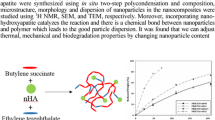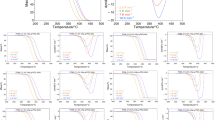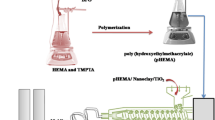The development of bio-compatible materials for bone implants bone healing is one of the key research areas in biomaterials. In this paper, composites of polyether-ether-ketone (PEEK) (a bio-compatible polymer) and hydroxyapatite (HA) were synthesized using thermal process, The qualities of the composites were analyzed with X-ray diffraction (XRD), Fourier-transform infrared spectroscopy (FTIR) for characterizing the nature of stress and bonding. The morphological study of the PEEK-HA composites were studied through Scanning electron microscopy. The compressive nature of the composites as well as raw materials was observed based on XRD data with internal lattice-strain analysis. The temperature-modulated differential scanning calorimetry (TM-DSC) and conventional differential scanning calorimetry (DSC) were performed for analyzing the crystallization process. The TM-DSC showed that both reversing and non-reversing processes were active during the crystallization between 160 °C–330 °C. However, a higher residual time of PEEK at elevated temperatures tends to facilitate polymer degradation and spread the crystallization process over a broader temperature range. Addition of HA particles provided heterogeneous nucleation sites for crystallization but also reduced the mobility of polymer chains. The combination of enhanced nucleation rate, reduced chain mobility and polymer degradation processes together lead to a wide range of crystallinity in PEEK-HA composites.
















Similar content being viewed by others
References
Ghalia MA, Dahman Y (2017) Biodegradable poly(lactic acid)-based scaffolds: synthesis and biomedical applications. J Polym Res 24:74–22. https://doi.org/10.1007/s10965-017-1227-2
Deviate SN, Physics C, York W, et al (2011) Encyclopedic dictionary of polymers. Springer New York, New York
Blundell DJ, Osborn BN (1983) The morphology of poly(aryl-ether-ether-ketone). Polymer (Guildf) 24:953–958. https://doi.org/10.1016/0032-3861(83)90144-1
Zhang Y, Li J, Zhang Z et al (2019) Dynamical behaviors of polylactide crystallization. J Polym Res 26. https://doi.org/10.1007/s10965-019-1698-4
Williams DF, McNamara A, Turner RM (1987) Potential of polyetheretherketone (PEEK) and carbon-fibre-reinforced PEEK in medical applications. J Mater Sci Lett 6:188–190. https://doi.org/10.1007/BF01728981
Rae PJ, Brown EN, Orler EB (2007) The mechanical properties of poly(ether-ether-ketone) (PEEK) with emphasis on the large compressive strain response. Polymer (Guildf) 48:598–615. https://doi.org/10.1016/j.polymer.2006.11.032
Kurtz SM, Devine JN (2007) PEEK biomaterials in trauma, orthopedic, and spinal implants. Biomaterials 28:4845–4869. https://doi.org/10.1016/j.biomaterials.2007.07.013
Abu Bakar MS, Cheng MHW, Tang SM et al (2003) Tensile properties, tension-tension fatigue and biological response of polyetheretherketone-hydroxyapatite composites for load-bearing orthopedic implants. Biomaterials 24:2245–2250. https://doi.org/10.1016/S0142-9612(03)00028-0
Ma R, Tang T (2014) Current strategies to improve the bioactivity of PEEK. Int J Mol Sci 15:5426–5445. https://doi.org/10.3390/ijms15045426
Liu C, Chan K, Shen J et al (2016) Polyetheretherketone hybrid composites with bioactive Nanohydroxyapatite and multiwalled carbon nanotube fillers. Polymers (Basel) 8:425. https://doi.org/10.3390/polym8120425
Asare-Yeboah K, Bi S, He Z, Li D (2016) Temperature gradient controlled crystal growth from TIPS pentacene-poly(α-methyl styrene) blends for improving performance of organic thin film transistors. Org Electron 32:195–199. https://doi.org/10.1016/j.orgel.2016.02.028
He Z, Shaik S, Bi S, et al (2015) Air-stable solution-processed n -channel organic thin film transistors with polymer-enhanced morphology 183301:1–6
Bi S, Li Y, He Z et al (2019) Self-assembly diketopyrrolopyrrole-based materials and polymer blend with enhanced crystal alignment and property for organic field-effect transistors. Org Electron 65:96–99. https://doi.org/10.1016/j.orgel.2018.11.008
Chen J, Shao M, Xiao K et al (2013) Conjugated polymer-mediated polymorphism of a high performance, small-molecule organic semiconductor with tuned intermolecular interactions, enhanced long-range order, and charge transport. Chem Mater 25:4378–4386. https://doi.org/10.1021/cm403039y
He Z, Xiao K, Durant W et al (2011) Enhanced performance consistency in nanoparticle/TIPS pentacene-based organic thin film transistors. Adv Funct Mater 21:3617–3623. https://doi.org/10.1002/adfm.201002656
Okazaki Y, Gotoh E (2005) Comparison of metal release from various metallic biomaterials in vitro. Biomaterials 26:11–21. https://doi.org/10.1016/j.biomaterials.2004.02.005
Scharf B, Clement CC, Zolla V et al (2015) Molecular analysis of chromium and cobalt-related toxicity. Sci Rep 4:5729. https://doi.org/10.1038/srep05729
Ajami S, Coathup MJ, Khoury J, Blunn GW (2017) Augmenting the bioactivity of polyetheretherketone using a novel accelerated neutral atom beam technique. J Biomed Mater Res - Part B Appl Biomater 105:1438–1446. https://doi.org/10.1002/jbm.b.33681
dos Santos SA, Rodrigues BVM, Oliveira FC et al (2019) Characterization and in vitro and in vivo assessment of poly(butylene adipate-co-terephthalate)/nano-hydroxyapatite composites as scaffolds for bone tissue engineering. J Polym Res 26:53–11. https://doi.org/10.1007/s10965-019-1706-8
Converse GL, Yue W, Roeder RK (2007) Processing and tensile properties of hydroxyapatite-whisker-reinforced polyetheretherketone. Biomaterials 28:927–935. https://doi.org/10.1016/j.biomaterials.2006.10.031
Li K, Yeung CY, Yeung KWK, Tjong SC (2012) Sintered hydroxyapatite/polyetheretherketone nanocomposites: mechanical behavior and biocompatibility. Adv Eng Mater 14:155–165. https://doi.org/10.1002/adem.201080145
Ma R, Tang S, Tan H et al (2014) Preparation, characterization, and in vitro osteoblast functions of a nano-hydroxyapatite/polyetheretherketone biocomposite as orthopedic implant material. Int J Nanomedicine 9:3949–3961. https://doi.org/10.2147/IJN.S67358
Chan KW, Liao CZ, Wong HM et al (2016) Preparation of polyetheretherketone composites with nanohydroxyapatite rods and carbon nanofibers having high strength, good biocompatibility and excellent thermal stability. RSC Adv 6:19417–19429. https://doi.org/10.1039/c5ra22134j
Liliana Burakowski Nohara, Michelle Leali Costa, Mauro Angelo Alves, Marta Ferreira Koyama Takahashi, Evandro Luís Nohara, Mirabel Cerqueira Rezende, (2010) Processing of high performance composites based on peek by aqueous suspension prepregging. Materials Research 13 (2):245–252
Jonas A, Legras R (1991) Thermal stability and crystallization of poly(aryl ether ether ketone). Polymer (Guildf) 32:2691–2706. https://doi.org/10.1016/0032-3861(91)90095-Z
Kuo MC, Huang JC, Chen M (2006) Non-isothermal crystallization kinetic behavior of alumina nanoparticle filled poly(ether ether ketone). Mater Chem Phys 99:258–268. https://doi.org/10.1016/j.matchemphys.2005.10.021
Rigano L, Lionetti N (2016) Nanobiomaterials in galenic formulations and cosmetics. In: Nanobiomaterials in Galenic Formulations and Cosmetics. Elsevier, pp 121–148
Kuo MC, Tsai CM, Huang JC, Chen M (2005) PEEK composites reinforced by nano-sized SiO2 and A1 2O3^Os particulates. Mater Chem Phys 90:185–195. https://doi.org/10.1016/j.matchemphys.2004.10.009
Okazaki I, Wunderlich B (1997) Reversible melting in polymer crystals detected by temperature-modulated differential scanning calorimetry. Macromolecules 30:1758–1764. https://doi.org/10.1021/ma961539d
Rivera-Muñoz EM, Velázquez-Castillo R, Huirache-Acuña R et al (2012) Synthesis and characterization of hydroxyapatite-based nanostructures: nanoparticles, Nanoplates, Nanofibers and Nanoribbons. Mater Sci Forum 706–709:589–594. https://doi.org/10.4028/www.scientific.net/MSF.706-709.589
Zhao F, Li D, Jin Z (2018) Preliminary investigation of poly-ether-ether-ketone based on fused deposition modeling for medical applications. Materials (Basel) 11:288. https://doi.org/10.3390/ma11020288
Panda RN, Hsieh MF, Chung RJ, Chin TS (2003) FTIR, XRD, SEM and solid state NMR investigations of carbonate-containing hydroxyapatite nano-particles synthesized by hydroxide-gel technique. J Phys Chem Solids 64:193–199. https://doi.org/10.1016/S0022-3697(02)00257-3
Righetti M (2017) Crystallization of polymers investigated by temperature-modulated DSC. Materials (Basel) 10:442. https://doi.org/10.3390/ma10040442
Chalmers JM, Everall NJ, Ellison S (1996) Specular reflectance: a convenient tool for polymer characterisation by FTIR-microscopy? Micron 27:315–328. https://doi.org/10.1016/S0968-4328(96)00021-2
Koziara BT, Nijmeijer K, Benes NE (2015) Optical anisotropy, molecular orientations, and internal stresses in thin sulfonated poly(ether ether ketone) films. J Mater Sci 50:3031–3040. https://doi.org/10.1007/s10853-015-8844-0
Yusong P, Qianqian S, Yan C (2013) Fabrication and characterisation of functional gradient hydroxyapatite reinforced poly (ether ether ketone) biocomposites. Micro &. Nano Lett 8:357–361. https://doi.org/10.1049/mnl.2013.0265
Ma R, Guo D (2019) Evaluating the bioactivity of a hydroxyapatite-incorporated polyetheretherketone biocomposite. J Orthop Surg Res 14:1–13. https://doi.org/10.1186/s13018-019-1069-1
Hosseinpour M, Zendehnam A, Hamidi Sangdehi SM, Ghomi Marzdashti H (2019) Effects of different gas flow rates and non-perpendicular incidence angles of argon cold atmospheric-pressure plasma jet on silver thin film treatment. J Theor Appl Phys 7. https://doi.org/10.1007/s40094-019-00351-7
Zhang MQ, Lu ZP, Friedrich K (1997) Thermal analysis of the wear debris of polyetheretherketone. Tribol Int 30:103–111. https://doi.org/10.1016/0301-679X(96)00028-X
Nguyen HX, Ishida H (1986) Molecular analysis of the crystallization behavior of poly(aryl-ether-ether-ketone). J Polym Sci Part B Polym Phys 24:1079–1091. https://doi.org/10.1002/polb.1986.090240510
Xu J, Ma Y, Hu W et al (2009) Cloning polymer single crystals through self-seeding. Nat Mater 8:348–353. https://doi.org/10.1038/nmat2405
Pae KD, Sauer JA (1968) Effects of thermal history on isotactic polypropylene. J Appl Polym Sci 12:1901–1919. https://doi.org/10.1002/app.1968.070120811
Day M, Deslandes Y, Roovers J, Suprunchuk T (1991) Effect of molecular weight on the crystallization behaviour of poly(aryl ether ether ketone): a differential scanning calorimetry study. Polymer (Guildf) 32:1258–1266. https://doi.org/10.1016/0032-3861(91)90230-G
Seo J, Gohn AM, Dubin O et al (2019) Isothermal crystallization of poly(ether ether ketone) with different molecular weights over a wide temperature range. Polym Cryst 2:e10055. https://doi.org/10.1002/pcr2.10055
Li H, Zhang B, Lin B et al (2018) Electrospun poly(ether ether ketone) nanofibrous separator with superior performance for lithium-ion batteries. J Electrochem Soc 165:A939–A946. https://doi.org/10.1149/2.0611805jes
Acknowledgements
Authors are thankful to Manipal Institute of Technology, India for the help in XRD characterization. Authors sincerely acknowledge Advanced Research in Polymeric Materials, India for extending their help in materials preparation and SEM characterization.
Author information
Authors and Affiliations
Corresponding author
Additional information
Publisher’s note
Springer Nature remains neutral with regard to jurisdictional claims in published maps and institutional affiliations.
Highlights
• PEEK-HA as a reusable material.
• Crystallization process consist of reversing and non-reversing processes
• It shows two peaks in DSC at the time of crystallization.
Rights and permissions
About this article
Cite this article
Dey, S.K., Chatterjee, S., Spieckermann, F. et al. Reversing and non-reversing effects of PEEK-HA composites on tuning cooling rate during crystallization. J Polym Res 26, 279 (2019). https://doi.org/10.1007/s10965-019-1967-2
Received:
Accepted:
Published:
DOI: https://doi.org/10.1007/s10965-019-1967-2




